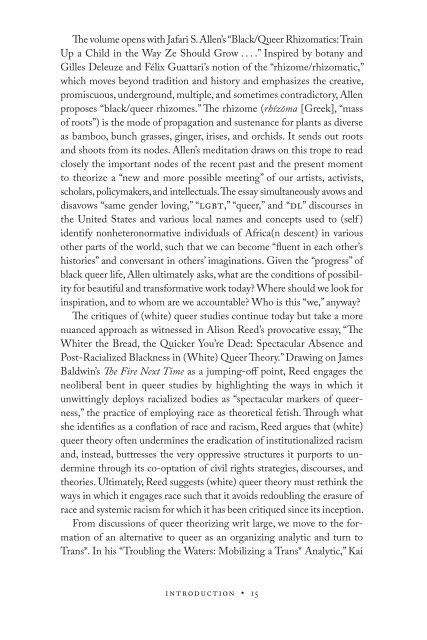No Tea
89AS6wvrf
89AS6wvrf
You also want an ePaper? Increase the reach of your titles
YUMPU automatically turns print PDFs into web optimized ePapers that Google loves.
The volume opens with Jafari S. Allen’s “Black/Queer Rhizomatics: Train<br />
Up a Child in the Way Ze Should Grow . . . .” Inspired by botany and<br />
Gilles Deleuze and Félix Guattari’s notion of the “rhizome/rhizomatic,”<br />
which moves beyond tradition and history and emphasizes the creative,<br />
promiscuous, underground, multiple, and sometimes contradictory, Allen<br />
proposes “black/queer rhizomes.” The rhizome (rhízōma [Greek], “mass<br />
of roots”) is the mode of propagation and sustenance for plants as diverse<br />
as bamboo, bunch grasses, ginger, irises, and orchids. It sends out roots<br />
and shoots from its nodes. Allen’s meditation draws on this trope to read<br />
closely the impor tant nodes of the recent past and the pres ent moment<br />
to theorize a “new and more pos si ble meeting” of our artists, activists,<br />
scholars, policymakers, and intellectuals. The essay si mul ta neously avows and<br />
disavows “same gender loving,” “lgbt,” “queer,” and “dl” discourses in<br />
the United States and vari ous local names and concepts used to (self )<br />
identify nonheteronormative individuals of Africa(n descent) in vari ous<br />
other parts of the world, such that we can become “fluent in each other’s<br />
histories” and conversant in others’ imaginations. Given the “pro gress” of<br />
black queer life, Allen ultimately asks, what are the conditions of possibility<br />
for beautiful and transformative work today? Where should we look for<br />
inspiration, and to whom are we accountable? Who is this “we,” anyway?<br />
The critiques of (white) queer studies continue today but take a more<br />
nuanced approach as witnessed in Alison Reed’s provocative essay, “The<br />
Whiter the Bread, the Quicker You’re Dead: Spectacular Absence and<br />
Post-Racialized Blackness in (White) Queer Theory.” Drawing on James<br />
Baldwin’s The Fire Next Time as a jumping- off point, Reed engages the<br />
neoliberal bent in queer studies by highlighting the ways in which it<br />
unwittingly deploys racialized bodies as “spectacular markers of queerness,”<br />
the practice of employing race as theoretical fetish. Through what<br />
she identifies as a conflation of race and racism, Reed argues that (white)<br />
queer theory often undermines the eradication of institutionalized racism<br />
and, instead, buttresses the very oppressive structures it purports to undermine<br />
through its co- optation of civil rights strategies, discourses, and<br />
theories. Ultimately, Reed suggests (white) queer theory must rethink the<br />
ways in which it engages race such that it avoids redoubling the erasure of<br />
race and systemic racism for which it has been critiqued since its inception.<br />
From discussions of queer theorizing writ large, we move to the formation<br />
of an alternative to queer as an organ izing analytic and turn to<br />
Trans*. In his “Troubling the Waters: Mobilizing a Trans* Analytic,” Kai<br />
Introduction • 15


